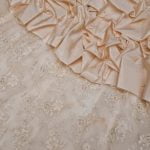What does wearing a veil at your wedding mean? The practice of donning a veil has a long and rich history, with deep cultural and symbolic significance. From its origins to its evolution over time, the tradition of wearing veils at weddings has varied greatly across different cultures and religions. This article will delve into the history of veils, exploring how this timeless bridal accessory has come to hold such profound meaning for brides around the world.
The history of wedding veils is steeped in tradition and symbolism, dating back centuries. From ancient Roman times to modern-day ceremonies, the veil has played a pivotal role in bridal attire. This section will examine the historical roots of veils at weddings, shedding light on how this practice has changed and adapted over time.
Moreover, this article will explore the different cultural and religious meanings associated with veils at weddings. From symbolizing purity and modesty to warding off evil spirits, veils hold varying significances across different traditions. By examining these diverse perspectives, we can gain a deeper understanding of the universal appeal of veils as a symbol of love and commitment.
Symbolism of Veils in Different Cultures
Veils have long held a significant role in weddings across various cultures and religions. The symbolism of veils in different traditions varies widely, reflecting the unique beliefs and customs of each group. Here are some examples to illustrate the significance of veils in different cultures:
- Christianity: In Christian weddings, the veil is often seen as a symbol of modesty and purity. It is also believed to represent the bride’s transition from being under her father’s care to being under her husband’s protection.
- Hinduism: In Hindu weddings, the veil – known as ghunghat – holds similar connotations, with its primary purpose being to shield the bride from the gaze of others before she meets her groom. It symbolizes her modesty and reverence.
- Islam: Within Islamic traditions, the hijab serves as a form of modesty and privacy for women, encompassing not just veiling but also attire that covers certain parts of the body. This practice is an essential aspect of Muslim wedding ceremonies.
It is important to note that while veils may carry similar meanings across various cultures, there are also differences in their symbolism from one tradition to another. Understanding these differences can shed light on the diverse ways in which veils are perceived and valued around the world.
In some cultures, wearing a veil at a wedding may also be connected to superstitions or spiritual beliefs. For instance, in ancient Rome, brides wore flame-colored veils as a means of protecting themselves from evil spirits. In contrast, Ukrainian brides traditionally wear embroidered veils known as “rushnyk” for good luck and fertility.
As we continue to embrace diversity and cultural exchange in wedding practices, it becomes increasingly important to recognize and respect these varied meanings associated with wearing a veil at one’s wedding.
Types of Wedding Veils
When it comes to choosing a wedding veil, there are numerous options available for brides to consider. From traditional cathedral veils to more modern birdcage veils, each style holds its own significance and can impact the overall bridal look. Here are some of the most common types of wedding veils:
- Cathedral Veil: This is the longest type of veil, typically extending beyond the train of the bride’s gown. It adds an air of regal elegance and is often chosen for formal or traditional weddings.
- Chapel Veil: Slightly shorter than the cathedral veil, it usually extends just past the length of the bride’s gown. It provides a graceful and classic look without being overwhelming.
- Blusher Veil: A short veil that covers the bride’s face and is lifted by her father or partner during the ceremony. It adds a sense of anticipation and mystery as it frames the bride’s face before she meets her partner at the altar.
- Elbow Length Veil: Falling at around elbow length, this style complements most dress silhouettes and is a versatile choice for various wedding themes and settings.
- Birdcage Veil: A modern and fashionable option that covers only part of the bride’s face, often stopping at the nose or chin. It adds a touch of retro glamour and pairs well with vintage-inspired gowns.
Each type of veil carries its own symbolism and can be chosen based on personal style preferences as well as cultural and religious traditions. Ultimately, selecting a wedding veil comes down to how it complements the bride’s dress and overall vision for her special day.
For many brides, choosing a veil is not just about finding an accessory that looks beautiful-it’s also about what does wearing a veil at your wedding mean to them personally. Whether they opt for a classic cathedral style or a modern birdcage design, wearing a veil on their wedding day can evoke feelings of tradition, meaningfully connect them to their culture or heritage, or simply make them feel like an ethereal bride ready to walk down the aisle.
The Bridal Veil and Its Connection to Femininity
The Purity and Modesty Symbolism
Throughout history, the bridal veil has been strongly associated with femininity, purity, and modesty. In many cultures, the white wedding gown and veil have symbolized the bride’s purity, innocence, and virginity.
This tradition dates back to ancient Rome and Greece when brides wore a veil to protect them from evil spirits. The symbolism of purity and modesty is still prevalent in many modern weddings, where brides choose to wear a traditional long veil as a symbolic representation of these virtues.
Evolution of Symbolism
In today’s society, the symbolism of the bridal veil has evolved significantly. While some brides still adhere to the traditional meaning, others see it as a fashion statement or simply as a beautiful accessory to complement their wedding attire. Some choose to forego wearing veils altogether in favor of more modern headpieces or hairstyles that reflect their personal style. The evolution of this symbol underlines the changing perceptions of femininity and what it means for women in contemporary culture.
Embracing Femininity on Your Terms
For many modern brides, wearing a veil is more about embracing their femininity on their own terms rather than conforming to outdated traditions. It can be seen as a way for brides to feel elegant, graceful, and beautiful on their special day without being tied down by societal expectations of what symbolizes femininity.
The decision to wear a veil becomes an empowering choice that allows each bride to express herself in her unique way while acknowledging the historical significance of this timeless tradition within her cultural context.
Veils and Superstitions
Historical Superstitions
Throughout history, veils have been associated with protection and warding off evil spirits. In ancient times, it was believed that evil spirits would attempt to curse the bride on her wedding day, so the veil was worn to conceal her beauty from these malevolent entities. Additionally, some cultures believed that brides should wear veils to confuse any evil forces seeking to harm her.
Modern Interpretations
While many modern brides may not believe in superstitions, there are still those who choose to honor tradition by wearing a veil for its symbolic protection. For some, it is seen as a way of embracing their cultural heritage or paying homage to their ancestors. Others may view it as a fun and lighthearted nod to tradition without necessarily subscribing to beliefs in evil spirits.
Protective Symbolism
One interpretation of wearing a veil is that it serves as a protective shield against negativity and ill wishes. Whether rooted in superstition or simply as a ceremonial tradition, the act of donning a veil can be seen as a symbolic form of protection for the bride as she enters into this new chapter of her life. The veil becomes a physical embodiment of love, support, and safeguarding against anything that may threaten the couple’s happiness.
The Psychological Significance of Wearing a Veil
For many brides, wearing a veil on their wedding day holds deep psychological significance. Traditionally, the bridal veil was used to symbolize purity and modesty, but today, it carries various emotional meanings for different brides. For some, the act of wearing a veil connects them to generations of women who came before them and followed the same tradition. This sense of continuity and tradition can bring about a feeling of groundedness and emotional connection to the ceremony for the bride.
Additionally, wearing a veil can also evoke feelings of mystery and anticipation for the bride as she prepares to walk down the aisle. The veil partially conceals her face and creates an aura of excitement as she unveils herself at the altar. This act can create a sense of heightened emotion and significance during this pivotal moment in the wedding ceremony.
Furthermore, donning a veil can also be seen as a nod to personal style and self-expression. Modern bridal veils come in a variety of styles and lengths, allowing each bride to choose one that reflects her individual personality. The ability to select a veil that resonates with her own sense of style can empower a bride to feel confident and beautiful on her special day.
Personal Stories and Experiences
When it comes to wearing a veil on your wedding day, many brides have different reasons and personal meanings behind this tradition. For some, it may be a nod to tradition and cultural significance, while for others, it may hold deep personal meaning. Many brides feel a connection to their family’s history and heritage when they choose to wear a veil.
It symbolizes not only the union of two people but also the merging of two families and the continuation of traditions from generations past. Other brides feel that wearing a veil adds an air of elegance, mystery, and romance to their bridal look.
One real-life story comes from Sarah, who chose to wear her grandmother’s cathedral-length veil on her wedding day as a way to honor her memory. She felt that by wearing the same veil her grandmother wore on her own wedding day, she was carrying on a legacy of love and happiness within her family. This deeply personal connection made her wedding day even more meaningful and emotional.
Another bride, Maria, shared how wearing a veil made her feel connected to centuries-old traditions and customs. As she walked down the aisle in her lace-trimmed mantilla veil, she felt like she was part of something larger than herself – an unbroken chain of women who had walked the same path before her.
| Personal Story | Meaning |
|---|---|
| Sarah wore her grandmother’s veil | Honoring family legacy |
| Maria chose a lace-trimmed mantilla veil | Connection to centuries-old traditions |
Modern Perspectives on Veils
In conclusion, the tradition of wearing a veil at a wedding holds deep historical and cultural significance, as well as personal and modern interpretations. Throughout history, veils have been used to symbolize purity, modesty, and protection from evil spirits, with various lengths and styles reflecting different cultural and religious traditions. While some brides still choose to honor these traditional meanings, many others today interpret the veil as a fashion statement or simply an accessory to complement their bridal look.
The psychological aspect of wearing a veil on one’s wedding day cannot be overlooked either. For many brides, donning a veil is a way to feel emotionally connected to the ceremony or to embody a sense of tradition. However, in modern times, more and more brides are choosing not to wear veils at all, opting instead for other headpieces or even no headpiece at all. This shift reflects changing perspectives on marriage and individuality.
Ultimately, the meaning of wearing a veil at a wedding has evolved alongside societal changes and personal beliefs. Whether seen as a symbol of tradition and femininity or simply as an aesthetic choice, the decision to wear a veil is deeply personal for each bride. Despite its historical roots and cultural significance, the choice is now left up to each individual bride to decide what it means for her on her special day.
Frequently Asked Questions
What Is the Point of a Wedding Veil?
The wedding veil has historically been used to symbolize modesty and purity, but today it is more of a fashion statement. It adds an element of drama and romance to the bride’s overall look.
What Is the Symbolism of a Wedding Veil?
The wedding veil has various symbolic meanings across different cultures. In some traditions, it represents the bride’s virginity and her departure from her parents’ home. In others, it signifies her transition from being single to married.
Who Should Wear a Wedding Veil?
Traditionally, the bride wears a wedding veil as part of her bridal attire. However, in modern times, wearing a veil is entirely up to the preferences of the bride.
Some brides choose not to wear veils at all, while others opt for alternatives like headpieces or hair accessories that suit their personal style. Ultimately, the decision of who should wear a wedding veil lies with the individual bride and what makes her feel most beautiful on her special day.

Welcome to my blog about home and family. This blog is a place where I will share my thoughts, ideas, and experiences related to these important topics. I am a stay-at-home mom with two young children. I hope you enjoy reading it! and may find some helpful tips and ideas that will make your home and family life even better!





